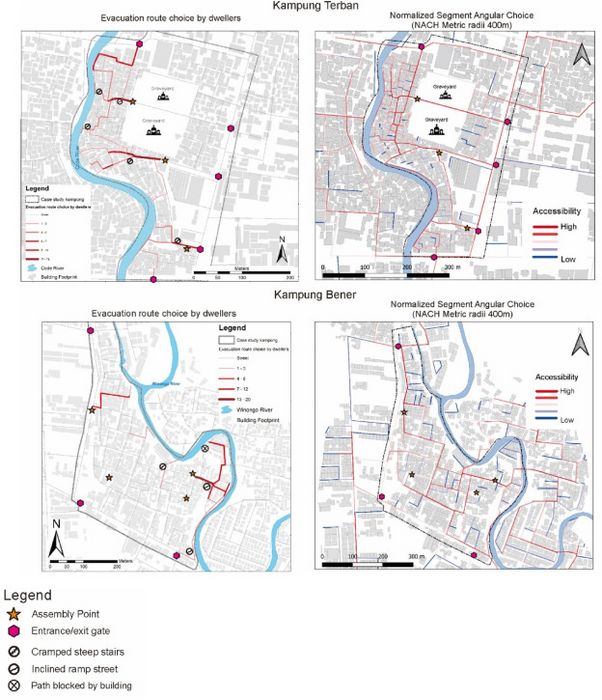Emergency evacuation is an important disaster response action. Recent frequent instances of natural and man-made disasters necessitate effective evacuation planning. It involves factors such as road network properties, street geometry, path risk, and environmental information. Such plans are difficult to implement because of the complex psychological reactions of the affected people during an emergency. For instance, in flood disaster preparation, the responsiveness and resilience of a community at risk are crucial. However, little is known about how informal settlement dwellers negotiate their surroundings during evacuation.

Credit: Hitoshi Nakamura from SIT, Japan
Emergency evacuation is an important disaster response action. Recent frequent instances of natural and man-made disasters necessitate effective evacuation planning. It involves factors such as road network properties, street geometry, path risk, and environmental information. Such plans are difficult to implement because of the complex psychological reactions of the affected people during an emergency. For instance, in flood disaster preparation, the responsiveness and resilience of a community at risk are crucial. However, little is known about how informal settlement dwellers negotiate their surroundings during evacuation.
Recently, Mr. Irsyad Adhi Waskita Hutama (a Doctoral Program student) and Professor Hitoshi Nakamura of Shibaura Institute of Technology, Japan, analyzed the dynamic interaction between human characteristics, path risk elements, and path network configuration in constructing flood evacuation route choices. The study was conducted in Terban and Bener, which are two urban riverbank kampongs (villages) in Yogyakarta, Indonesia. Their findings were made available online on 1st September 2022 and published in Volume 81 of the International Journal of Disaster Risk Reduction on 15th October 2022.
Prof. Nakamura reveals his motivation behind the research: “Riverbank kampongs in Indonesian cities have grown spontaneously. Their residents typically include low-income and marginalized people who lack disaster prevention infrastructure. I am interested in how such communities can undertake disaster risk management and mitigate future disasters. A study on evacuation measures in riverbank kampongs will indicate reliable life-saving actions in response to flood, earthquake, and other disasters.”
The researchers applied a mixed-method approach. First, they collected extensive data regarding path risk factors through walking evacuation simulations recorded on video. Next, walking interviews were conducted to gain exploratory information on individual capacity and decision-making. Finally, the researchers performed computational path network analysis using the Space syntax model. The results of these analyses were combined to paint the overall picture.
Their findings suggest that riverbank kampong dwellers select evacuation routes based on their individual capacity and the safety performance of path design. Many of them rely on safety perception instead of following spatial logic. Consequently, their evacuation route decisions might be compromised. Moreover, the walking interview revealed that men had higher spatial legibility and path safety perception than women in both case studies.
Further, the researchers juxtaposed the Space syntax results with the walking evacuation simulation. The individual evacuation route selection was found to be highly related to the “normalized angular choice at local radii.” This implies that a majority of residents prefer to walk on the straightest route—with the least angular deviation—to reach the assembly points. Furthermore, in agreement with the personal interviews, the residents have different capabilities to walk on the straightest evacuation path. In particular, physical capacity, gender, and age affected people’s decisions in negotiating path risk elements and accommodating the safest travel.
Prof. Nakamura points out the long-term implications of the study. “Our study attempts to bridge the research tradition on disaster studies that focus on the morphological approach on one hand, and a human-centered approach on the other. Its findings indicate a policy insight that includes routine disaster prevention actions consistent with the socio-spatial profile of the kampong’s marginalized. The enhancement includes not only structural measures such as human-sensitive urban design, readability of evacuation routes through signage, and the provision of evacuation infrastructure but also community preparedness. These measures should be included in kampong upgrading and slum alleviation policies aimed at achieving the SDGs.”
Overall, the study highlights the use of mixed-method approaches and emphasizes the need to consider the human-centered perspective in effective flood emergency evacuation planning for informal riverbank settlements.
***
Reference
DOI: https://doi.org/10.1016/j.ijdrr.2022.103275
About Shibaura Institute of Technology (SIT), Japan
Shibaura Institute of Technology (SIT) is a private university with campuses in Tokyo and Saitama. Since the establishment of its predecessor, Tokyo Higher School of Industry and Commerce, in 1927, it has maintained “learning through practice” as its philosophy in the education of engineers. SIT was the only private science and engineering university selected for the Top Global University Project sponsored by the Ministry of Education, Culture, Sports, Science and Technology and will receive support from the ministry for 10 years starting from the 2014 academic year. Its motto, “Nurturing engineers who learn from society and contribute to society,” reflects its mission of fostering scientists and engineers who can contribute to the sustainable growth of the world by exposing their over 8,000 students to culturally diverse environments, where they learn to cope, collaborate, and relate with fellow students from around the world.
Website: https://www.shibaura-it.ac.jp/en/
About Professor Hitoshi Nakamura from SIT, Japan
Prof. Hitoshi Nakamura is the Dean of Graduate School of Engineering and Science at the Shibaura Institute of Technology, Japan. He received the Doctor of Engineering degree from The University of Tokyo in 2006. Prof. Nakamura has actively contributed to the field for more than 25 years. He has published around 85 research papers. His research interests include urban and regional planning, community design, disaster risk reduction, and climate change adaptation.
Journal
International Journal of Disaster Risk Reduction
DOI
10.1016/j.ijdrr.2022.103275
Method of Research
Case study
Subject of Research
People
Article Title
Flood disaster evacuation route choice in Indonesian urban riverbank kampong: Exploring the role of individual characteristics, path risk elements, and path network configuration
Article Publication Date
15-Oct-2022
COI Statement
The authors declare that they have no known competing financial interests or personal relationships that could have appeared to influence the work reported in this paper.




